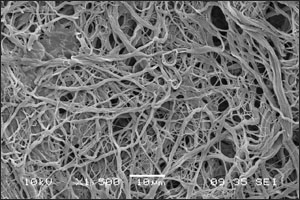Science
Cellulose: Answering the Call for Sustainable Energy

What do silicon, fire, and cellulose all have in common? Just ask Laura Flynn, a senior biochemistry major who is working on a research project with American University professor Douglas Fox to modify cellulose so it can be used as an all-fiber flame retardant. You may be wondering what is so great about a flame-inhibiting product made solely from the naturally abundant plant material cellulose. Well, not only is cellulose readily available in the natural environment, but it also serves as a very effective insulation material. And with the chemical modification that Fox’s team is currently working on in Beeghly Laboratory, it can be quite successful in inhibiting fire. The team in Fox’s lab, consisting of three to four AU students from varying science backgrounds, hopes to contribute to growing evidence proving the effectiveness of environmentally abundant, non-artificial flame retardants in order to promote sustainability and energy consciousness.
Cellulose, a naturally abundant organic compound, is the structural component of plants and bacterial cell walls. It is useful in the production of products like paper, textiles, or insulation because the abundance of polar hydroxyl groups in each cellulose molecule gives it the ability to interact with adjacent molecules in order to form fibers. When woven together in long, linear structures, cellulose makes a physically strong and durable building material, ideal for building insulation. However, in its natural form, cellulose is extremely flammable and therefore does not meet the federal government’s safety standards for insulation that is protective against the threat of fire. Before being used, it must first be modified or treated, oftentimes with borate salts, to decrease its flammability. This is where Flynn’s research comes in. The first year of the research project, according to Flynn, “consisted mostly of chemical research,” centered on attaching side chains to produce the desired chemical substance and then utilizing the technique of Fourier transmission infrared spectroscopy (FTIS) to determine whether the correct substance was in fact obtained. Now, in a later stage of research, the main focus of the project is to determine the effectiveness of their all-fiber polymers at retarding flame. While in the lab, located in the Beeghly Chemistry Building, Flynn spends many long hours using FTIS to determine the exact chemical composition of the substances she works with, as well as a machine called an extruder to push cellulose into materials in order to decrease their flammability. She hopes her work will contribute to the growing drive for sustainable sources of building insulation by proving chemically modified cellulose to be an ideal candidate.
Flynn began working with Fox after she took his Biophysical Chemistry class last year. As a professor in both the Chemistry and Environmental Science departments, Fox is interested in “green chemistry,” and his interests related to the use of natural, environmentally sustainable products for everyday purposes inspired Laura to join his research team. Fox and his student laboratory assistants are drawn to the specific research of increasing cellulose’s ability to resist fire, primarily because of its high potential for use as an exceedingly sustainable form of insulation.
The usage of cellulose as a fire-resistant insulation in building material promotes environmental sustainability in two different ways. Firstly, the pure abundance of cellulose in the natural environment renders it an ideal candidate for widespread use in many aspects of everyday life. Each day it is estimated that plants produce nearly 50 kg cellulose for each person on earth, so there is plenty of cellulose to go around, Since cellulose is found in abundance in plant materials, constructing insulation out of it results in far less carbon emission than the production of its synthetic insulation counterparts. For example, while fiberglass is both effective and widely used as a fireproof insulation material, its production requires energy for the acquisition of the raw materials that go into making it, as well as for the actual manufacturing process. This energy most often comes from the combustion of fossil fuels—those nasty but undeniably useful fuels that cause the emission of carbon dioxide. Finding sustainable sources of production and seeking new ways to reduce CO2 emissions has been all the rage in recent decades since the environmental consciousness movement began picking up steam around 1970, the year of the first Earth Day. Flynn’s use of cellulose insulation as a substitute for synthetics will undoubtedly help decrease greenhouse gas emissions.
A second reason that cellulose insulation is environmentally sustainable is that it is an exceptionally effective insulator. Because of its high density, it can be quite successful at minimizing air leaks between the interior of a building and the outside environment. As a result of more effective insulation, buildings require less heat during the winter and less air conditioning during the summer. When the usage of electricity is decreased, carbon dioxide emissions and the production of ozone-depleting greenhouse gases is therefore reduced.
The project in Fox’s lab is funded by the National Institute of Standards and Technology (NIST), which has its headquarters in Gaithersburg, Md. As an agency of the U.S. Department of Commerce, NIST promotes innovation that improves economic security and enhances our quality of life. The institute is funding this project because of a current lack of options for sustainable flame retardants with low environmental and health safety risks.
This spring, Fox presented his work at the American Chemical Society National Meeting and Exposition in San Diego, Calif. As the global science community continues to focus on environmental conservation and efficient use of resources, projects such as this, which promote sustainable development, will shape the future of scientific research.
